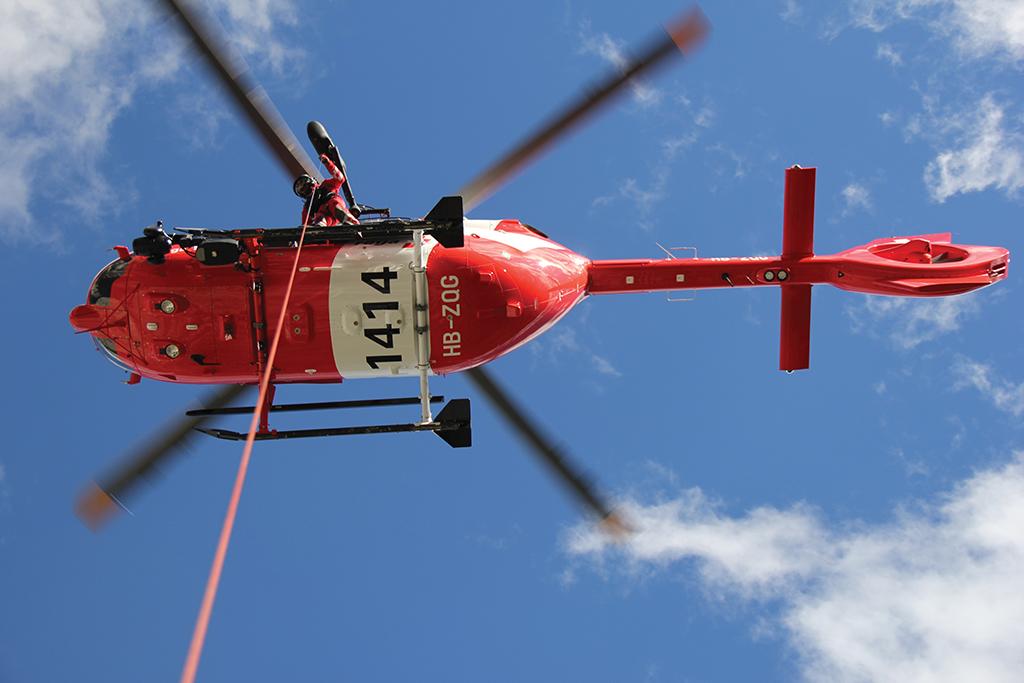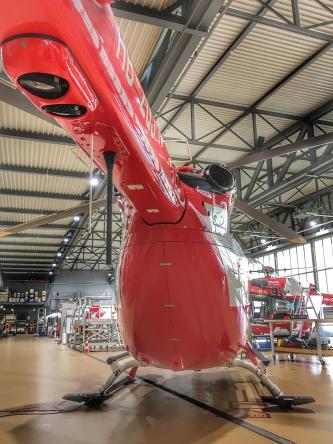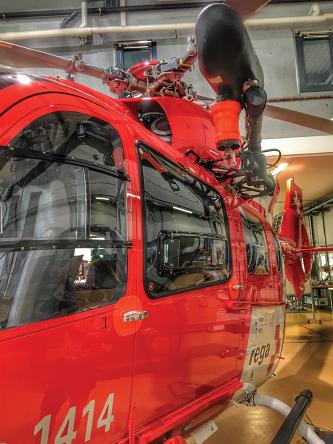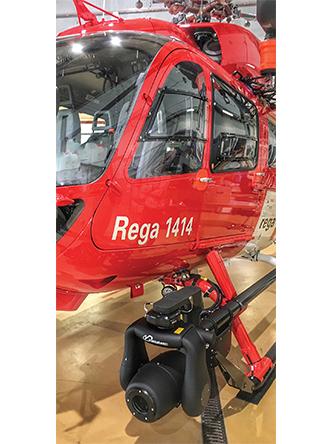Rega To The Rescue: Innovative Alpine Operation Has Global Reach

Helicopter emergency medical service (HEMS) is an especially challenging mission when performed among mountains where high density altitudes, tricky winds and steep, unforgiving terrain are ever-present threats. When the weather deteriorates, which can happen rapidly in the mountains, the lack of an IFR en route network and VFR-only non-icing-capable helicopters has often ended badly.
However, an expectant mother with a premature delivery living in a remote village in the Alps can now be airlifted to a hospital by an IFR-certified helicopter flying along an IFR network even during inclement weather. That critical transportation is provided by Rega, shorthand for Rettungsflugwacht, meaning “air rescue service.”
BCA was given the courtesy of a base visit to the Swiss non-profit’s Zurich headquarters in November 2018 and as part of a college tour led by this author in May 2019. During the latter, our group was treated to an in-depth presentation and guided tour from Dr. Olivier Seiler, Rega’s former deputy medical director, and Reni Fritschi, the head of its subscription office. Rega’s media service spokesman Adrian Schindler was our host on the initial visit.

In 2018, Rega came to the aid of 11,579 patients and organized more than 17,000 missions. Its helicopters flew a total of 12,573 missions that year, a 6.8% increase over 2017, and its jet fleet flew 980 missions, a 10.8% increase over the previous year. On an average day service personnel will care for approximately 32 patients. On peak days its helicopters have been called upon to perform 90 missions. One of its busiest days was Dec. 31, 2017, when Rega’s helicopter crews performed 110 missions throughout the alpine country.
Rega currently operates 19 helicopters and three medical jets. The helicopter fleet comprises seven Airbus Helicopters H145 light twins, stationed at the lowland bases in Zurich, Basel, Bern, Lausanne and St. Gallen, and 11 AgustaWestland (now Leonardo) specialized twin-engine models located at the mountain bases in Untervaz, Locarno, Erstfeld, Samedan, Wilderswil, Mollis and Zweisimmen. These networks connect with major trauma centers in Basel, St. Gallen, Zurich, Bern and Geneva.
Each base has a three-person team, composed of a pilot, paramedic and flight physician, with the goal of reaching the scene of the emergency within 15 min. For many years, Rega has been working with the anesthesiology departments of the central hospitals closest to its helicopter bases and uses their staff doctors as flight physicians.
At any one time, six helicopters are in reserve, either undergoing maintenance or being used for training. All maintenance is done at Rega’s headquarters at Zurich International Airport. Rega also operates an Airbus Helicopters H125 for training.
In May 2019, Rega’s status was renewed by the Commission on Accreditation of Medical Transport Systems (CAMTS) and remains the only European organization certified both for aeromedical helicopter, ambulance jet operations and for medically escorted repatriations.

One of the many aspects of Rega’s flight operations that differentiate it from others is its rescues by winch. Much of Switzerland’s terrain is unsuitable for even vertical landings since obstacles can pose a risk of rotor blade contact. Thus the fleet-wide use of cables, which when extended to their full length of 90 meters, the system’s electric motor can lift up to two people to the helicopter in approximately 2 min. From his position next to the open cabin door, the paramedic uses a remote control device to lower the flight physician (and sometimes also a rescue specialist from the Swiss Alpine Club) down to the injured person, then raise the patient once the physician signals.
The amount of crew coordination during winch operations is extensive. Rega has posted a video to allow others to view these missions and to understand how important it is that the crewmembers communicate well with each other. The video can be seen at: www.rega.ch
Rega helicopters also utilize a long-line system to rescue injured mountain climbers from vertical or overhanging rock faces. The line, which is up to 200 meters long, is suspended from the bottom hook of the helicopter and carries a rescuer.
Severe injuries in alpine terrain can sometimes involve the spine and these must be treated with extra care since even a slightly wrong motion could result in permanent paralysis. Even stabilizing a broken leg must be done with great care to avoid inflicting the patient with excruciating pain. To mitigate such problems, Rega has created a “vacuum sack” that immobilizes the patient in a secure position for transport. The patient is then laid into a special “air rescue sack” that is attached to the rescue winch and either hoisted into the helicopter or, depending on circumstances, left suspended and flown to the nearest possible landing site, and there transferred into the helicopter for transport to a medical facility.
Alpine IFR
An Achilles’ heel to HEMS safety in the U.S. has been encounters with weather that exceeds the capability of the pilot or rotorcraft, or both, and results in accidents. This problem becomes magnified when the weather occurs in mountainous terrain.
It is Rega’s position that an IFR-equipped helicopter operated by an IFR-current pilot within an instrument en route and approach system can avoid such danger. Moreover, today’s satellite-based technology affords the rotary-wing community the ability to develop such an IFR infrastructure even in the deepest mountain valleys. The Rega personnel also realized that when the need for an on-scene landing arises, as it often does in HEMS operations, the IFR infrastructure could be followed to a VFR breakout point whereupon the helicopter could then often proceed visually to the rescue scene.

Accordingly, Rega has been working closely with the Swiss Air Force and Skyguide air navigation service to establish a network of instrument flight routes through the Swiss Alps. This Low Flight Network (LFN) is based on satellite navigation and links airfields with permanent IFR infrastructures, as well as hospitals and smaller airfields with specially designed approaches. At the end of 2014, the last Agusta/Leonardo machine was fitted with a second navigation computer and a second global positioning system/satellite-based augmentation system (GPS/SBAS) and subsequently IFR-certified by the Federal Office of Civil Aviation (FOCA).
In collaboration with the European project group Precision Based Navigation Rotorcraft Operations under Demonstration (PROuD), the precision of this technology was established during test flights conducted in July 2015. PROuD promotes the introduction of satellite-based helicopter flight procedures and is funded by the EU, the aviation industry and the European air traffic control authority.
The testing involved a Rega Agusta/Leonardo helicopter flying from Samedan/Engadin Airport, located in a high alpine valley 5 km from St. Moritz. At an elevation of 1,707 meters (5,600 ft.), it is the highest airport in Europe that allows airliner traffic and is considered one of the most challenging airports in the world because of its difficult topography, winds and high density altitude. The route traversed through topographically challenging terrain over the Julier Pass, via Savognin through the Surses valley, on to Thusis, and finally to Graubünden Cantonal Hospital in Chur.
The main LFN routes, north-south and east-west, were certified for rescue missions during day conditions in December 2016. On the 16th of that month, Rega transported its first patient on an instrument flight route of the LFN over the imposing terrain of the Gotthard Pass. Then on Dec. 23, 2017, FOCA granted Rega special authorization to use key intersections of the network around the clock. These included the military airfields in Emmen and Meiringen, as well as the IFR approaches to the hospital helipad in Bern.
Another key component for an all-weather rescue system is the availability of current weather information around the clock along with the communication capability to transmit it to the cockpit. Without this, IFR operations are not permitted.
“Thor,” Rega’s major effort to provide this data, included installing approximately 60 new weather stations and webcams at key locations throughout the Alps. In addition, Rega modernized the radio network and operating devices in the helicopters to allow a better transfer of that data between its Operations Center and the cockpits of its rotary fleet.
And since Rega’s mission success requires the ability to fly in icing conditions, it spent two years evaluating different aircraft before signing a contract for three new all-weather Agusta/Leonardo AW169-FIPS helicopters. Equipped with anti-icing systems, the new models are to begin operation in 2021 and partially replace the current H145 lowland fleet. With the purchase of the -FIPS machines, Rega is a major step closer to its goal of performing rescues regardless of the weather outside.
Total acquisition costs are estimated to be 50 million Swiss francs ($51.6 million) for the three machines, including the necessary medical equipment. This sum has already been earmarked in Rega’s long-term financial planning, and the company’s healthy financial position means that this project can be funded without outside capital.
“With the new rescue helicopter, we will be able to extend our scope of operation and in the future come to the aid of more people in distress than ever before,” says Rega CEO Ernst Kohler. In addition to its full ice protection system, the AW169-FIPS will be equipped with state-of-the-art avionics enabling the rotorcraft to perform high-precision instrument flights. Once these components of an IFR system are implemented, injured and sick patients from peripheral regions in Switzerland will have timely access to advanced medical care.
Giving Pilots Proper Tools
Approximately one-quarter of Rega’s helicopter missions occur in darkness. At night, overhead cables and clouds are very difficult to detect and so Rega pilots use night-vision goggles (NVG), which intensify the existing light by a factor of up to 25,000. The result is a green-colored image in which roads, clouds and the landscape are clearly visible when the ambient light conditions permit. In contrast, in remote valleys with limited light, hardly a moon and heavy overcast, the NVGs bring little improvement. The equipment is not used during landing nor during winch operations because of the pilot’s need to estimate distance accurately.
Rega has signed a long-term agreement with Elbit to jointly market and equip its helicopters with Elbit’s ClearVision HeliEVS. The system merges the input of a high-definition visual camera and a long-wave IR sensor into one high-quality fused picture. It detects helipad, rig and runway lights with provisions to support a color display. The system projects images onto a helmet-mounted display allowing Rega’s pilots to “see” risks and obstacles even when visibility is poor.
Its AW169s will also be equipped with the Laser Obstacle Avoidance Monitoring system manufactured by Selex EX in Genoa. The system utilizes an eye-safe laser technology to detect all kinds of obstacles, especially thin ones including power lines and aerial gondola cables (both common in Swiss valleys), along a helicopter’s path. The warning allows a pilot to make timely corrections to the flight path.
A Special Simulator
In spring 2013, Rega’s new simulator for its Agusta/Leonardo mountain helicopters went into operation. The simulator used for initial and recurrent training in the A109 is located nearby at the Lufthansa training facility close to Zurich Airport. The Level-B certified sim has a 220-deg.-by-60-deg. field of view. Data loaded into the visual software includes hospital helipads frequented by Rega’s pilots.

In order to fly IFR, helicopter pilots must complete between 400 and 500 hr. of classroom training, as well as a minimum of 55 hr. of flight training. All Rega helicopter pilots fly around 50 training hours in the flight simulator and an additional 20 training hours in the helicopter. The Level B certification allows the simulator to be used for compulsory check flights. The simulator provides the additional capability of training for hoist procedures. The unique ability of this simulator to replicate external load missions enables both flight crews and paramedics to practice as a crew. (I understand the realism of the visual scene is so good that it can induce vertigo to anyone looking over the “edge” of the open door in the rear cabin while lowering the winch.) All Agusta/Leonardo pilots as well as paramedics complete up to eight training exercises in the simulator every year.
Coordination Center
Each rescue mission starts with an emergency call into Rega’s Operation Center. Anyone anywhere in Switzerland can connect with the rescue coordinator by dialing 1414. The ultra-modern center on the second floor of Rega’s main building on Zurich Airport is staffed 24/7/365. The unit is divided into two sections, with one dealing with missions within Switzerland and almost always involving its helicopters, while the other focuses on missions outside the country and primarily involve fixed-wing transport.

When the green light at a coordinator’s desk illuminates, the operators, all of whom are proficient in all four of Switzerland’s official languages, respond, aided by an automated information system designed to expedite the exchange. One of their first tasks is to determine the location of the caller or victim. More than 80% of incoming phone calls are received from cellphones, but that doesn’t guarantee the person making the phone call can give an accurate location, especially if a visitor. So, Rega developed a special app that automatically displays the sender’s position on the coordinator’s screen. (See “Multifunction App” sidebar.) With the push of a button, the digitally transmitted mission coordinates are fed into the mission helicopter’s FMS and appear on the map display in the cockpit.
The coordinator can quickly determine the nearest rescue helicopter available for dispatch. If this happens to be in the canton of Valais, the coordinators work immediately with their counterparts at Air Glacier (which operates predominantly in the French-speaking region of the canton) or Air Zermatt (which serves the canton’s German-speaking region).
The flight coordinators have four screens that display not only the various maps and satellite images but other important information to include meteorology and avalanche data as well as potential obstacles near the victim’s location. Rega partner organizations including Skyguide, the Swiss Air Force, MeteoSchweiz and the Institute for Snow and Avalanche Research quickly compile the information for the coordinators.
The Rega ops center also organizes missions for the mountain rescuers with the Swiss Alpine Club. And notably in a country where alpine cheese production is a serious business and a definitive part of its culture, Rega also performs animal transports on behalf of Swiss mountain farmers.
Repatriation Service
Rega provides worldwide repatriation for “patrons” — more on that later in the article — who get injured abroad where medical care either is insufficient or, after receiving initial treatment, the person requires ambulatory transport back to Switzerland. The “abroad” section of the ops center coordinates and organizes those missions. The flight coordinator is assisted by a medical coordinator who works with the foreign hospital or medical service. Beyond that, thousands of patients, their friends or family contact Rega from places all over the world for assistance in finding suitable locations for diagnoses and treatment.

Rega’s medical consultants have visited 6,000 hospitals worldwide for inspections to “see behind the doors,” so they know first-hand the quality of medical care at those facilities. This extensive hospital database is an indispensable resource. In some cases, expert advice based upon this information can eliminate the need for a repatriation flight. However, if Rega’s medical coordinators deem that the standard of care is insufficient at the location, the patient will be retrieved and flown back to Switzerland. The medical coordinator will determine when the patient is fit enough to be flown, and whether this should take place in a sitting or lying flat position.
Rega utilizes two forms of fixed-wing aircraft for repatriation flights. It can use scheduled airline service (which the airlines apparently don’t like very much) or one of Rega’s long-range Bombardier CL-650s, which are the equivalent of high-speed, long-range airborne ICUs.
Repatriation from abroad requires intricate flight planning. For example, at the time of our visit, tensions continued to mount in Kashmir, forcing Swiss and other European airlines to delay and reroute flights because of the disputed airspace. Pakistan closed its airspace following military skirmishes, and shortly thereafter Afghanistan had closed access to its skies. Rega’s jets fly under the authority of the International Red Cross and Red Crescent, thus in theory it should have access to more airspace. Despite this, the risk of transiting airspace overlying hostile ground actions must still be weighed. The dispatcher continues planning the optimal route taking the jet stream’s projected position and strength into calculation, determining if the leg has enough fuel required and if not, planning fuel stops.
One of the special planning tasks involves a risk assessment to minimize the crew’s exposure to communicable diseases from the patients, all of whom will be confined in the same, relatively small aircraft and breathing the same air for lengthy periods. So, proper hygiene and health procedures must be employed to protect Rega crews, patients and the Swiss population. Accordingly, Rega works with Swiss Tropical and Public Health Institute in Basel when there are health questions. The Division of Infectious Diseases and Hospital Epidemiology at the Zurich University Hospital provides professional support in this area as well.
When major international catastrophes strike and a number of Swiss citizens are grievously injured, the repatriation effort can be formidable. For example, when a tsunami struck Southeast Asia in December 2004, 16 Rega medical teams spent 10 days in the affected regions. Rega’s jets flew to the disaster area four times. A total of 60 patients were transported back to Switzerland in a variety of ways. This disaster put the ultimate stress test on the team members.
It doesn’t take a large natural disaster to demand extensive resources. In July 2011, a seriously ill woman in Canada and a seriously injured woman in Hawaii both needed intensive care transport. HB-JRC took off from Zurich on July 27 directly for Sondrestromfjord (Greenland) then Vancouver for refueling. In order to meet the long mission routing it was necessary to staff the aircraft with two flight crews, accompanied by a flight physician and intensive care nurse. During the “off” time the reserve flight crew is able to rest in the bunk beds of the cabin. Roughly 16 hr. later, the aircraft landed in Maui where the flight crewmembers promptly went to a hotel to rest. The next day they had the injured woman onboard and departed for Vancouver to pick up the second patient. The return trip overflew Greenland and landed back in Zurich on July 30 after more than 31 hr. in the air.
Rega recently upgraded its fleet of fixed-wing long-range jets to the capable Bombardier Challenger 650, which has a 6,500-km nonstop range. Last year, the jets flew 4,690 flight hours, or the equivalent of 76 circumnavigations. That also equates to an impressive annual 1,563 flight hours per airframe for the year.
On the day of our visit in May 2019 each of the trio of jets was dispatched to far-flung parts of the globe. One was fetching a patient in the Philippines and another patient in India. The second was headed to Bosnia and Herzegovina. The third jet was on its way to Corsica then Spain.
During our visit in late 2018, we were invited to tour a Challenger undergoing modifications. In order to gently move stretcher patients in and out of the aircraft, Rega constructed a three-piece ramp of synthetic fibers, which is permanently installed in the jets. The ramp folds into the aircraft’s main door.
Forward in the aircraft are bunks, necessary for the additional crewmembers required for long mission days that can take them to locations halfway around the globe.
Aeromedical transport of patients requiring advanced care sometimes demands specialized equipment to accommodate medical needs related to heart and lung concerns and premature births. Rega’s helicopters and jets regularly carry cardiovascular support equipment and on those missions are accompanied by certified cardiovascular specialists. The premature birth portable kit (termed “Preemie” in the industry) is designed to be capable with all aircraft. The kit weighs 127 kg to support a 1-kg baby. Also, in 2017, Rega equipped its rescue helicopters and ambulance jets with a newly designed video laryngoscope, which provides images to help secure a patient’s airway.
One of the difficulties of being a pioneer in modifying these aircraft in such a manner is that the Swiss certification authorities have never seen such mods and thus the review and approval process is lengthy.
A Different Kind of Funding
Another unique aspect about Rega is its status as a privately run, non-profit foundation that operates independently of the government or any other financial interests. The operation is funded by its “patrons,” essentially individual annual subscribers who number nearly 3.5 million in a country with 8.5 million residents, or 41% of the Swiss population. Those funds support the company of 410 employees, most of whom are flight coordinators, medical personnel and mechanics, along with 72 pilots.
In grateful acknowledgement of this support, Rega can waive the costs of rescue missions carried out on patrons’ behalf in the event that insurance companies or any other third party are not liable to pay. (Unofficial travel tip: If you contemplate doing any hiking or skiing in Switzerland, I highly recommend buying one of the well-recognized Rega “rescue cards.” The annual subscription card costs just 30 Swiss francs, or about the same in U.S. dollars, for an individual or 70 Swiss francs for a family and is arguably one of the best insurance policies you’ll ever buy.)
If those individuals being airlifted are not Rega patrons, the service is charged to their insurance providers and any unpaid balance is their responsibility.
What started as innovative ideas by aviators concerned with providing humanitarian rescue in the alpine environment has evolved into an organization that provides expedited patient care for transit to higher levels of medical care. The innovations by this respected Swiss rescue organization have aided patients needing care not only in remote Swiss alpine locations but also throughout the world.
Editor’s Note: Rega has been selected by Aviation Week Network editors and contributors to receive the Business Aviation Operations Laureate. The award will be presented in Washington on March 12.





